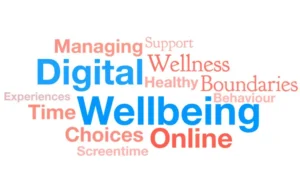While it might seem counterintuitive to use technology to fight technology, the right digital tools can actually help you reclaim control over your screen habits. Smart use of apps, settings, and digital strategies can transform your devices from sources of distraction into allies for better focus and productivity.
Understanding the Problem
Digital overwhelm affects millions of people worldwide, with the average adult spending over seven hours daily looking at screens. This constant exposure creates a cycle of distraction that rewires our brains for short attention spans and immediate gratification. Research shows that frequent task-switching between apps and notifications can reduce productivity by up to 40%, while also increasing stress hormones like cortisol.
The problem extends beyond simple time management. Excessive screen time disrupts sleep patterns through blue light exposure, diminishes face-to-face social skills, and creates dopamine addiction loops that make it increasingly difficult to engage in slower, more contemplative activities. Understanding these mechanisms helps explain why willpower alone often fails to address screen time issues.
Tech Solutions for Focus
Focus-enhancing apps represent the frontline of digital wellness tools. Applications like Forest gamify concentration by growing virtual trees during focused work sessions, while Freedom blocks distracting websites and apps across multiple devices simultaneously. These tools work by removing temptation and creating positive reinforcement for sustained attention.
Brain training apps offer another approach, though their effectiveness remains debated among researchers. Apps like Lumosity and Peak provide cognitive exercises designed to strengthen working memory and attention control. While these don’t necessarily translate to improved focus in real-world situations, they can help users become more aware of their attention patterns and develop mindfulness around mental processes.
Creating a Balanced Tech Diet
Digital wellness requires the same intentionality as nutritional health. A balanced tech diet involves consuming technology mindfully, choosing high-quality digital experiences while avoiding empty “junk” consumption. This means prioritizing apps and websites that add genuine value to your life while eliminating those that merely provide mindless entertainment or social validation.
Screen time tracking apps built into iOS and Android provide detailed insights into device usage patterns. These tools reveal which apps consume the most time and attention, often surprising users with the reality of their digital habits. Armed with this data, you can make informed decisions about which applications deserve space in your daily routine and which should be limited or eliminated entirely.
Setting up digital boundaries involves both technological and behavioral changes. Do Not Disturb modes can be scheduled to automatically activate during focused work periods, meals, or before bedtime. Notification management becomes crucial—turning off non-essential alerts for social media, games, and entertainment apps while maintaining important communications from work, family, and emergency services.
The Role of Parental Controls
Parental control features extend beyond protecting children—they can be valuable tools for adults seeking to limit their own device usage. Screen Time on iOS and Digital Wellbeing on Android allow users to set app limits, schedule downtime, and restrict access to specific categories of applications during designated hours.
Third-party parental control apps like Qustodio and Circle Home Plus offer more granular control over internet access and app usage. These tools can block specific websites during work hours, limit social media access to certain times of day, or completely restrict access to problematic apps and sites. The key is setting up these restrictions during moments of clarity and motivation, making it harder to override them during moments of weakness.
Combining Tech with Traditional Methods
The most effective focus strategies combine technological tools with time-tested traditional methods. Physical notebooks and planners can work alongside productivity apps, providing a tactile experience that many people find more engaging than digital alternatives. The act of writing by hand activates different neural pathways than typing, often leading to better retention and deeper processing of information.
Environmental modifications support technological solutions by creating physical spaces optimized for focus. This might involve setting up a dedicated workspace free from personal devices, using noise-canceling headphones with focus-enhancing audio, or implementing lighting solutions that support circadian rhythms and reduce eye strain during screen use.
Personalizing Your Tech Strategy
Effective digital wellness requires personalization based on individual needs, work requirements, and lifestyle factors. A freelance graphic designer will need different screen time strategies than a teacher or a construction worker. Understanding your unique relationship with technology helps determine which tools and approaches will be most effective for your situation.
Experimentation becomes essential when developing a personalized tech strategy. This might involve trying different focus apps for several weeks each, testing various notification schedules, or experimenting with different levels of restriction to find the optimal balance between accessibility and limitation. Keep a simple log of what works and what doesn’t to refine your approach over time.
Future Trends in Focus Tech
Artificial intelligence is beginning to play a larger role in focus enhancement tools. Smart assistants can learn your work patterns and proactively suggest focus sessions, while AI-powered apps analyze your behavior to identify optimal times for deep work. These systems aim to enhance their sophistication by anticipating potential distractions and taking action before you lose focus.
Wearable technology offers new possibilities for focus monitoring and enhancement. Devices that track heart rate variability, stress levels, and brain activity can provide real-time feedback about your attention state. Future wearables may be able to detect when you’re becoming distracted and automatically trigger focus-enhancing interventions like breathing exercises or environmental adjustments.
Taking Control of Your Digital Life
Reducing screen time and improving focus through technology requires a strategic approach that combines the right tools with consistent implementation. The irony of using technology to combat technology’s negative effects isn’t lost on most users, but this approach leverages our devices’ sophisticated capabilities to support human well-being rather than exploit psychological vulnerabilities.
Begin by putting into practice one or two strategies that are most relevant to your current circumstances. Whether that’s setting up app limits, trying a focus-enhancing application, or creating device-free zones in your home, small consistent changes often lead to significant improvements in attention and overall life satisfaction. Remember that the goal isn’t to eliminate technology from your life but to ensure that your tech use aligns with your values and supports your ability to focus on what matters most.
FAQs
1. How long does it take to see improvements in focus using these tech tools?
Most people notice initial improvements within a few days of implementing screen time limits and focus apps, but significant changes in attention span and concentration typically develop over 2-4 weeks of consistent use. The key is maintaining consistency rather than expecting immediate transformation.
2. Can I use these strategies if my job requires extensive screen time?
Absolutely. The goal isn’t to eliminate screen time but to use it more intentionally. Focus on reducing recreational screen time, managing notifications during work hours, and taking regular breaks to prevent mental fatigue. Many strategies can be adapted to work within professional requirements.
3. Are there any risks to using apps that block other apps?
The main risk is becoming overly dependent on external controls rather than developing internal self-regulation skills. It’s important to gradually build intrinsic motivation and awareness while using blocking apps as temporary support tools rather than permanent solutions.
4. How do I handle resistance from family or friends when implementing these changes?
Start with small, personal changes that don’t affect others, then gradually expand your boundaries. Communicate your goals and suggest alternative ways to connect that don’t rely heavily on digital devices. Leading by example often inspires others to consider their own tech habits.



